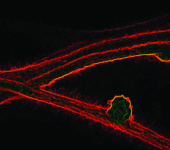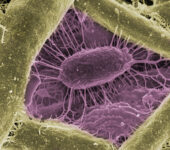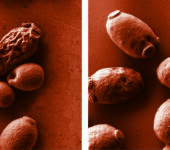BER/BERAC
-

Roots and Symbiont
Transgenic roots of Medicago truncatula with nodules formed by its symbiont (Sinorhizobium meliloti).
-

Microbes on Arabidopsis Roots
A magnified view of a microbe on Arabidopsis plant roots seemingly provides a “window” into the rhizosphere, or root zone. In fact, that’s exactly what a multi-institute research campaign is trying to frame—a view into the world of soil, roots and microorganisms. The image was obtained at EMSL, the Environmental Molecular Sciences Laboratory, a U.S. Department of Energy Office of Science national scientific user facility located at Pacific Northwest National Laboratory. The campaign includes scientists from EMSL, Pacific Northwest National Laboratory, DOE’s Joint Genome Institute, Brookhaven National Laboratory, and the Universities of Minnesota and Missouri. Funded by DOE’s Office of Biological and Environmental Research, the study examines carbon presence and distribution within the root zone, and impacts to rhizosphere microbial community diversity and functions. Results could surface climate and environmental solutions.
Research team members: Ljiljana Paša-Tolić, Charles Ansong, Heather Brewer, Alice Dohnalkova, Abigail Ferrieri, Kim Hixson, Meng Markillie, Angela Norbeck and Galya Orr of PNNL’s Earth and Biological Sciences Directorate; Susannah Green Tringe (DOE-JGI), Richard Ferrieri (BNL), Mike Sadowsky, Chanlan Chun and Christopher Staley of the University of Minnesota; and Gary Stacey, Yaya Cui and Lihui Song of the University of Missouri.
The image was captured with a Helios Nanolab dual-beam focused ion beam/scanning electron microscope at EMSL and colorized by Alice Dohnalkova.
-

Gene Expression
To understand how plants respond to various environments, Oak Ridge National Laboratory (ORNL) researchers have mapped gene expression in plants that use different photosynthesis strategies. Here, blue edges show positive correlations in gene expression between Kalanchoë genes (dark green nodes) and pineapple genes (yellow nodes). Red edges show negative correlations between gene expression in Kalanchoë and pineapple and in Arabidopsis (light green nodes), a model plant that uses a different photosynthesis strategy.
-

Symbiotic Interactions
Fluorescence in situ hybridization image of the endobacteria Mycoavidus sp. in the fungus Mortierella elongata. Cyan: M. elongata nuclei; magenta: M. elongata mitochondria 16S rRNA; yellow: Mycoavidus sp. 16S rRNA. Scientists use such bioimaging techniques to understand the mechanisms driving the interactions and functions of soil bacteria and fungi.
-

Integrative Genomics
Inside the DOE Joint Genome Institute’s Integrative Genomics Building. Closeup view of an Agilent Technologies metabolite analysis instrument. Mass spectrometry enables the analysis of complex samples for semi-quantitative and quantitative measurements and detection of novel secondary metabolites.
-

Yeast Strain Yarrowia lipolytica (Full View)
Scanning electron micrograph images of wild and laboratory-evolved Yarrowia lipolytica grown in a high concentration of ionic liquid. The evolved strain’s outer membrane displays much less disruption.
-

Minimizing Barriers to Research Participation
Community members may face various barriers to research participation, but taking steps to reduce these barriers helps ensure equitable selection of participants.
-

Institutional Review Board Protocol Components
The protocol helps the IRB determine if a study meets the regulatory criteria for approval, but it can also be a tool to help with research design. Working through the basic protocol components outlined here can help researchers think through and develop a project plan as well as anticipate and prepare for a variety of issues they may not have previously considered.
-

Human Subjects Research Milestones
Research regulations and standards have evolved throughout history. Unethical treatment of research participants led to the ethical principles outlined in the Belmont Report. These principles underpin the federal regulations in the Common Rule that govern research practices today.
-

Human Subject Research Evaluations
Belmont Report Core Principles. The Belmont Report outlines three core principles—respect for persons, beneficence, and justice—that institutional review boards use to evaluate human subjects research.